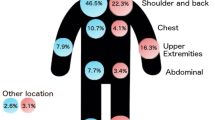Abstract
Background: Once individuals are diagnosed with malignant melanoma, they are at an increased risk of developing another melanoma when compared with the normal population.
Methods: To determine the impact of an intensive follow-up protocol on the stage of disease at diagnosis of subsequent primary melanomas, a retrospective query was performed of an electronic medical record database of 2,600 consecutively registered melanoma patients.
Results: Sixty-seven patients (2.6%) had another melanoma diagnosed at the time of presentation to the clinic or within 2 months (synchronous) and another 44 patients (1.7%) developed a second primary melanoma during the follow-up period (metachronous). For the 44 patients diagnosed with metachronous lesions, the Breslow mean tumor thickness for the first invasive melanoma was 2.27 mm compared with 0.90 mm for the second melanoma. The first melanomas diagnosed are thicker by an average of 3.8 mm (p=0.008). The mean Clark level for the initial melanoma was greater than the mean level for subsequently diagnosed melanomas (p=0.002). Twenty-three percent of the initial melanomas were ulcerated, whereas only one of the second primary lesions showed this adverse prognostic factor (p=0.002).
Conclusions: Once individuals are diagnosed with melanoma, they are in a high-risk population for having other primary site melanomas diagnosed and should be placed in an intensive follow-up protocol consisting of a complete skin examination.
Access this article
We’re sorry, something doesn't seem to be working properly.
Please try refreshing the page. If that doesn't work, please contact support so we can address the problem.
Similar content being viewed by others
References
Parker SL, Tong T, Bolden S, Wingo PA. Cancer Statistics, 1996.CA 1996;1:5–28.
English DR, Armstrong BK. Identifying people at high risk of cutaneous malignant melanoma: results from a case control study in Western Australia.Br Med J 1988;296:1285–8.
Masri GD, Clark WH, Gurcey D, Halpern A, Thompson CJ, Elder DE. Screening and surveillance of patients at high risk for melanoma result in detection of earlier disease.J Am Acad Dermatol 1990;22:1042–8.
Mackie RM, Aitchison TC, Freudenburger T. A personal risk factor chart for cutaneous melanoma.Lancet 1989;1:487–90.
Reintgen DS, Ross M, Bland K, Seigler HF, Balch C. Prevention and early detection of melanoma: a surgeon's perspective.Semin Surg Oncol 1993;9:174–87.
Jillella A, Mani S, Nair B, et al. The role for close follow-up of melanoma patients with AJCC stages I–III [Abstract 1311].Proc ASCO 1995;14:413.
Buzaid AC, Tinoco L, Rosa M, Legha S, Benjamin RS. Role of CT scan in the staging of melanoma patients with local/regional disease [Abstract 1303].Proc ASCO 1995;14:411.
Weiss M, Loprinzi CL, Creagan RJ, et al. Utility of follow-up tests for detecting disease—recurrence of surgically resected primary malignant melanoma.JAMA 1995;274:1703–5.
Reintgen DS, Cox C, Slingluff C, Seigler HF. Recurrent malignant melanoma: the identification of prognostic factors to predict survival.Ann Plast Surg 1992;28:45–9.
Reintgen DS, Cruse CW, Schroer KS, et al. Computer database for melanoma: a clinical management and research tool to ensure continuous quality assessment.Semin Surg Oncol 1993;9:208–14.
Marks R, Hill D. The outcome of melanoma education programs in Australia [Abstract]. Third International Conference on Melanoma.Melanoma Res 1993;3:7.
MacKie RM. What are the education and screening and diagnosis and prevention of melanoma achieving [Abstract]. Third International Conference on Melanoma.Melanoma Res 1993;3:7.
Reintgen DS, Cruse W, Wells K, et al: The effectiveness of skin cancer screening and continuing medical education programs toward increasing the survival of patients with malignant melanoma.Surg Oncol 1992;1:379–84.
Koh HK. Melanoma education and screening in the US.Melanoma Res 1993;3:7.
Temoshek L, DiClemente RJ, Severt DM, Mlois MS, Sagebel RW. Factors relating to patient delay in seeking medical attention for cutaneous malignant melanoma.Cancer 1984;54:3048–53.
Roush GC, McKay L, Holford TR. A reversal in the long-term increase in deaths attributable to malignant melanoma.Cancer 1992;69:1714–20.
Author information
Authors and Affiliations
Rights and permissions
About this article
Cite this article
Brobeil, A., Rapaport, D., Wells, K. et al. Multiple primary melanomas: Implications for screening and follow-up programs for melanoma. Annals of Surgical Oncology 4, 19–23 (1997). https://doi.org/10.1007/BF02316806
Received:
Accepted:
Issue Date:
DOI: https://doi.org/10.1007/BF02316806




